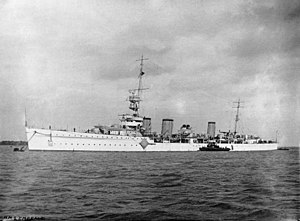
Back Леки крайцери тип „Емералд“ Bulgarian Třída Emerald Czech ناو کلاس امرالد Persian Emerald-luokka (risteilijä) Finnish Classe Emerald French Classe Emerald Italian エメラルド級軽巡洋艦 Japanese Krążowniki lekkie typu E Polish Лёгкие крейсера типа «Эмеральд» Russian Emerald-klass (kryssare) Swedish
 HMS Emerald
| |
| Class overview | |
|---|---|
| Name | Emerald class |
| Operators | |
| Preceded by | Danae class |
| Succeeded by | Leander class |
| In commission | 1926–1948 |
| Planned | 3 |
| Completed | 2 |
| Cancelled | 1 |
| Retired | 2 |
| General characteristics | |
| Type | Light cruiser |
| Displacement |
|
| Length | 570 ft (173.7 m) |
| Beam | 54.5 ft (16.6 m) |
| Draught | 16.5 ft (5.0 m) |
| Installed power | 80,000 shp (60,000 kW) |
| Propulsion |
|
| Speed | 33 kn (61 km/h; 38 mph) |
| Range |
|
| Endurance | 1,746 tons fuel oil |
| Complement | 572 |
| Armament |
|
| Armour |
|
| Aircraft carried | 1 × aircraft (later removed) |
| Aviation facilities | 1 × catapult (later removed) |
The Emerald class or E class was a class of two light cruisers built for the Royal Navy. Following the Cavendish class, three ships of a new class were ordered in March 1918, towards the end of World War I, designed to emphasise high speed at the cost of other qualities, for use against rumoured new high-speed German cruisers – like the Brummer class – and particularly minelayers, in the North Sea. The third ship was cancelled in November 1918.